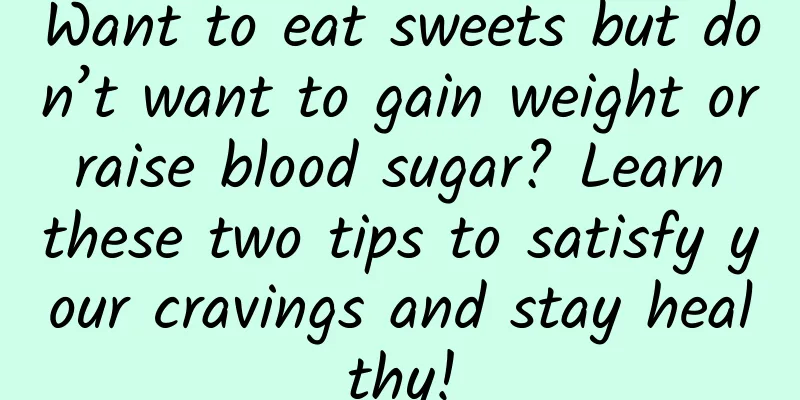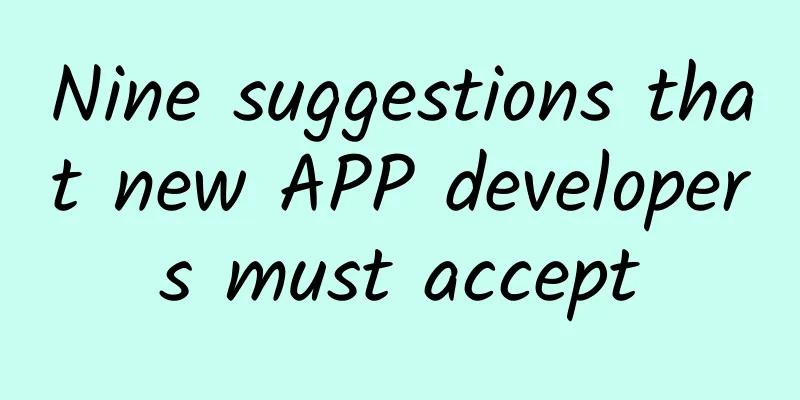Want to eat sweets but don’t want to gain weight or raise blood sugar? Learn these two tips to satisfy your cravings and stay healthy!

|
I believe many people have this dilemma: they want to eat some cookies or desserts occasionally, but they are worried about gaining weight and raising their blood sugar. In fact, for most healthy people, snacks and desserts are not dietary taboos if you don’t eat them every day or eat a lot. The key is to control the quantity and frequency. The so-called quantity control means controlling the amount of desserts you eat within the range of 50 grams of added sugar per day . If you do not drink sweet drinks, nor eat candies, preserved fruits, jams and other foods, and only eat a small cake of about 50 grams, it will not exceed the reasonable range. If you do not want to gain weight, you only need to increase exercise or reduce the amount of staple food accordingly. If you eat it occasionally, you don't have to worry about it. Copyright images in the gallery. Reprinting and using them may lead to copyright disputes. However, for those who need to control their blood sugar, they need to be more careful. Not only the quantity should be controlled, but also the time of eating dessert should be considered. Traditionally, Western-style meals are served with dessert after dinner. Now many restaurants also serve desserts after lunch or dinner. However, these foods can also be served as part of morning tea or afternoon tea, as a snack between meals. Especially when breakfast or lunch is light, it is reasonable to eat some snacks between meals. When is the best time to eat sweet snacks? So, when is the best time to eat these sweet snacks? Two previous studies have provided relevant evidence. One study compared the effects of consuming a sweet snack on blood sugar excursions in healthy women after lunch (12:30 p.m.), between lunch and dinner (15:30 p.m.), and after dinner (19:30 p.m.). The snack used is cake, which is the favorite of many girls. One piece has a calorie content of 498kcal, including about 28g of fat, 54g of carbohydrates and 8g of protein. Cake is really a calorie bomb. It looks soft, moist, and has a lot of moisture, but in fact, the softness is not caused by moisture, but by fat... The calorie values of the three meals are 351 kcal for breakfast, 549 kcal for lunch, and 656 kcal for dinner. This situation is very close to daily life. Although it is ideal to evenly supply calories and nutrients for the three meals, in reality, most people tend to eat a mediocre breakfast and the most abundant dinner. The female volunteers wore continuous blood glucose meters, which the researchers used to monitor their blood sugar fluctuations from lunch to breakfast the next day. Their average blood sugar curves are shown in Figure 1. Eating cake after lunch is represented by the green line. Eating cake after dinner is represented by the red line. Eating between meals is the blue line. It is clear that eating cake after dinner has the worst effect, with a particularly high blood sugar peak after dinner and the lowest blood sugar troughs between lunch-dinner and dinner-breakfast. Dinner is the largest portion of food, and with dessert, there are too many calories and a high total amount of carbohydrates, so it is understandable that the blood sugar peak is high. However, breakfast is small and lunch is not enough, so the blood sugar level will reach a trough 4 to 6 hours after lunch. What's worse is that the high blood sugar level after dinner affects the blood sugar response the next day. It is easy to have low blood sugar levels in the early morning and high blood sugar response after breakfast. Eating cake after lunch is much better. Although the blood sugar level at lunch drops slowly and there is a trough after 5-6 hours, the fluctuation is not that large and does not affect the blood sugar level after dinner and breakfast the next day. If you eat cake at 15:30 between lunch and dinner, it will cause little fluctuation in blood sugar, and prevent the blood sugar trough 4 to 6 hours after the meal. The blood sugar response at night and after breakfast the next day is also relatively stable. Experiments conducted on patients with type 2 diabetes found the same pattern: snacking between lunch and dinner is more effective than snacking after lunch. However, diabetics are more sensitive to food. Eating 17 grams of biscuits after lunch, which has only 75 kcal and contains only 13.5 grams of carbohydrates, can cause a significant increase in blood sugar fluctuations: the blood sugar peak after lunch rises higher and decreases too quickly, resulting in excessive blood sugar rises at dinner. If biscuits are eaten between meals, the blood sugar levels at lunch, dinner, and even in the early hours of the morning will become more stable, without such big ups and downs. Blood sugar stability is important Some people may say: If I eat more this time, my blood sugar will rise more, and if I eat less next time, my blood sugar will rise less, isn’t it the same in the end? In fact, it is different. This is because stable blood sugar is the most valuable. Excessive fluctuations in blood sugar are themselves a metabolic stress. Excessive fluctuations in blood sugar levels during the day are closely related to the risk of diabetic retinopathy and nervous system diseases, the risk of cardiovascular and cerebrovascular diseases, and all-cause mortality. Therefore, the measures to control blood sugar should not only control the fasting blood sugar value and the average value of blood sugar in a day, but more importantly, keep the daily blood sugar fluctuation as small as possible. In professional terms, it means to try to reduce the variability of blood sugar levels (glycemic variability, GV). Copyright images in the gallery. Reprinting and using them may lead to copyright disputes. Some studies have found that not having food for too long and eating when you are obviously hungry can cause your blood sugar to rise excessively. Other studies have found that for people who are accustomed to eating at a certain time, delaying lunch or dinner can also cause an increase in post-meal blood sugar response. In addition, research on pre-meal loading has found that eating foods containing carbohydrates 30 minutes before a meal can also effectively control the rise in blood sugar after a meal. In short, people who need to control blood sugar , including those who need to lose weight, should pay attention to maintaining a stable food intake and a stable carbohydrate supply, and it is best to reasonably distribute energy and carbohydrates among the three meals a day. If you need to add a snack, you may wish to put it in the middle of the two meals, or add a small snack half an hour before the meal. Planning and production Source: Fan Zhihong Original Nutrition Information Author: Fan Zhihong, Professor of the College of Food Science and Nutritional Engineering, China Agricultural University Editor: Wang Mengru |
<<: Your memory may be surpassed by chimpanzees | Nature Trumpet
Recommend
A 31-year-old female singer is diagnosed with advanced thyroid cancer. Why does thyroid cancer prefer young women?
On July 25, "Feng Timo posted a message conf...
Which drugs are in conflict with the "aura" of the popular sauce-flavored latte?
The recent popularity of Ruimao has given coffee ...
More than 90% of copywriting persuades consumers from these five dimensions
There are many ways to write copy with the ultima...
The best era for Chinese home appliances has just arrived
For Chinese home appliances, this is not the wors...
Giant viruses found in Greenland ice sheet, could it help alleviate global warming? | Nature Trumpet
Giant virus found in Greenland ice sheet It actua...
Create short video IP in the first year of 5G and make your fans addicted to you
2019 is known as the first year of 5G. The arriva...
Baijiahao operation skills, Baijiahao popular article skills
Today I will give you some of my humble opinions ...
Wang Hongjun: New energy buses face six development trends
From June 5th to 6th, the 2018 (9th) Global Autom...
Work five days a week and rest one day a week, combining work and rest: Let’s take a look at the “punch card” logs of “civil servants” in the Han Dynasty
Recently, General Secretary Xi Jinping visited th...
Subaru expands recall of 4 models due to Takata airbag issue
Recently, Subaru Automobile (China) Co., Ltd. fil...
It is reported that the second phase of Weilai's factory has started bidding, with an investment of 350 million yuan and a construction period of one year.
Recently, some media saw JAC Motors’ announcement...
A large wave of Android notch screens is coming, and the whole network is fully adapted!
[[225814]] 1. Preface Hi, everyone, I am Chengxia...
Which sprouted foods can be eaten? Which can’t be eaten?
Mixed Knowledge Specially designed to cure confus...
Google returns to China with these four points to make you buy in, are you willing?
[[154163]] Google's return to China has taken...
Gesture password
Source code introduction: An iOS gesture password...






![[Creative Cultivation Program] Is there any scientific basis for the claim that spanking can improve IQ?](/upload/images/67f265d8d2f16.webp)


